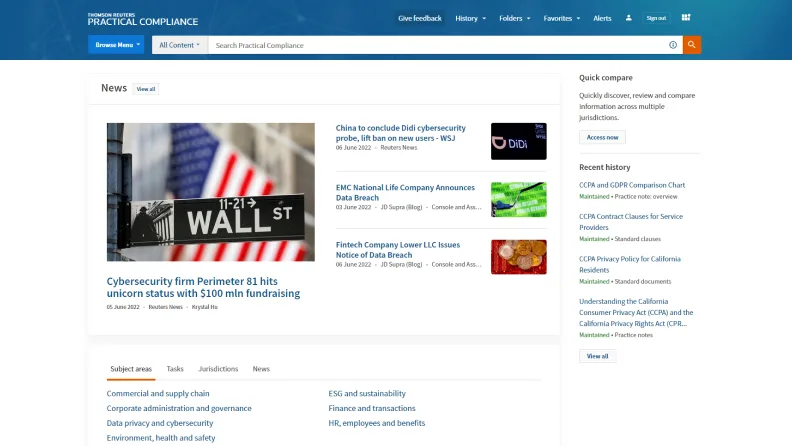Stay ahead of regulatory changes
In July 2025, U.K. regulators fined one of Britain’s biggest and oldest banks the equivalent of $56 million for not detecting and managing money-laundering risks relating to a couple of longtime high-risk clients.
Regulatory compliance can affect any type of organization, no matter the size.
In fact, compliance management missteps are all too easy to make. Organizations of all sizes and in numerous industries are having to navigate an ever-changing and often bewildering regulatory landscape. For organizations that conduct business in other countries, the complexity is even greater. All this makes it essential for risk and fraud professionals to keep pace with current compliance challenges and trends—and establish practical strategies for staying ahead of regulatory changes.
Jump to ↓
What is regulatory compliance?
Keeping up with a changing landscape
Building a resilient compliance framework
What is regulatory compliance?
Regulatory compliance is the process of maintaining adherence to all the laws, regulations, and industry standards that pertain to an organization’s operations. It helps organizations move through within legal boundaries and helps them avoid penalties, fines, and reputational damage that can result from being out of compliance.
What are these regulations for? In most cases, their purpose can be boiled down to one word: protection. For instance, financial institutions must comply with federal anti-money-laundering (AML) and know-your-customer (KYC) regulations to protect the public and the financial system. Publicly traded companies are required to conform with the requirements of the 2002 Sarbanes-Oxley Act (SOX). Manufacturers need to meet regulations regarding product environmental safety. And organizations in many industries, including government agencies, may need to conform to cybersecurity and data privacy rules.
By conforming to government and industry-specific regulations, organizations are thus protecting themselves as well as stakeholders. By addressing the risks associated with noncompliance, regulatory compliance protocols can help organizations manage risks better.
Core elements
Regulatory compliance management incorporates several core elements:
- Implementing written policies, procedures, and controls
- Continuously monitoring regulatory changes that pertain to the organization’s industry—and reviewing and updating policies as the regulatory landscape changes
- Conducting internal compliance inspections and auditing, along with external audits and reviews whenever appropriate
- Providing ongoing employee compliance training
These elements should make clear the relationship between compliance, risk management, and governance. Aligning an organization’s governance structures and policies with risk management and compliance efforts—a strategic approach often abbreviated as GRC—is intended to ensure consistent and effective operational decision-making. GRC practices also help organizations maintain accountability with regulators, customers, investors, and other stakeholders.
Keeping up with a changing landscape
One of the most challenging risks is trying to keep up with continually changing regulatory requirements. Rules and regulations can vary from state-to-state and country-to-country. That said, there are several areas where the pace of regulatory change is particularly rapid.
Areas that regulation effects
- Federal KYC and AML rules require businesses to conduct thorough due diligence of potential customers. Related to these requirements are know-your-vendor-(KYV) practices, which can overlap with KYC and AML protocols.
- Cybersecurity regulations are continually updated as data breaches keep proliferating. Healthcare-related organizations should already be familiar with HIPAA regulations for protecting patient data. Other pertinent data privacy rules are incorporated in the General Data Protection Regulation (GDPR) and the California Consumer Privacy Act (CCPA).
- AI can be an extremely helpful compliance and risk management tool. As this technology’s applicability grows, regulations regarding its ethical and responsible use will become more widespread. And given this technology’s evolving capabilities, those rules will constantly be revised.
- One other area likely to see increased regulatory activity is supply chain management as regulators worldwide wrestle with human rights issues and third-party risk.
- Another is human resources, where changing forms of employment, such as the gig economy, will require new forms of worker protection.
In short, maintaining compliance is highly complicated—and it will become even more complex in the future.
Building a resilient compliance framework
A regulatory compliance framework provides a structured set of policies and controls that can help an organization withstand regulatory scrutiny by managing and mitigating the risks associated with noncompliance.
Best practices
Since the regulatory landscape is shifting so frequently, organizations need a framework that is flexible enough to adjust to the inevitable changes. The key best practices of an effective regulatory compliance program should accommodate the core elements listed earlier.
- Policies and procedures that define specific actions and requirements for compliance within the organization
- Controls that ensure that policies and procedures are followed
- Monitoring that tracks compliance activities and changes in applicable regulations—and proactively address compliance gaps
- Reporting that measures performance to ensure ongoing compliance
In addition, an organization can benefit from instilling a culture of compliance that includes strategies for engagement and accountability throughout the business or agency. Such a culture includes establishing risk assessment methodologies that help employees analyze potential risks of noncompliance to the organization’s operations, finances, and reputation.
Elevating the process
In other words, organizations are increasingly under pressure to develop a resilient risk management process for regulatory compliance. Such a process usually comprises three main steps:
- Identifying all laws, regulations, and industry standards that might apply to the organization
- Analyzing the potential impact and likelihood of non-compliance with each identified risk
- Mitigating and managing these risks, which often requires implementing new controls or updating existing ones
Organizations should engage in ongoing monitoring and review to ensure controls are effective and to adapt to regulatory changes. Risk and fraud teams should maintain thorough documentation of the risk assessment process relating to regulatory compliance. This is crucial for demonstrating due diligence and accountability to regulators and to top executives.
Proper regulatory compliance is a massive job. Organizations will want to find ways to streamline compliance protocols, reducing redundancies and improving efficiency. This makes leveraging technology another compliance best practice.
But digital tools must be able to conduct compliance risk management scrupulously and rigorously. They should ensure that the organization is aware of all relevant regulations and changes in areas, and across all jurisdictions where it does business. The risks of noncompliance can be costly.

Regulatory compliance management
Stay updated on global regulatory developments and confidently manage compliance
Request free trial ↗








